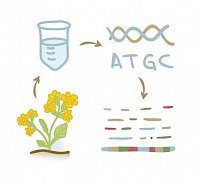Plant population genetic

We use population and landscape genomic molecular approaches (ddRADseq, targeted sequencing; earlier: AFLP, microsatellites) to study the genetic variation of plant populations. The results are often combined with environmental data (soil, climate) and biological data from e. g. germination and "common garden" experiments. Our research priorities are:
- Conservation Biology: we deal with the genetic diversity of rare and endangered grasslands species (such as Antennaria dioica, Primula veris, Viola pumila, and in previous research various Stipa species, Pulsatilla vulgaris, Adonis vernalis), and often associate the data with reproductive traits.
- Biological invasions: we analyze the genetic structure of populations of alien species and compare it with the situation in the regions of origin (e.g. Conyza canadensis, Centaurea stoebe, or in previous studies Buddleja davidii, Rosa rubiginosa, Ulmus pumila).
- Evolutionary ecology: we are interested in how environmental gradients determine phenotypic among-population variation through local adaptation. In this context, we often use biological invasions as models to study eco-evolutionary principles at contemporary time scales.
- Phylogeography: we try to understand historical events such as postglacial migration of steppe plants and that of (sub-)tropical high mountain species.
Related projects:
- iConnect - Integrative Conyza network for contemporary trait evolution (DFG project)
- "The use of herbarium specimen to track spatio-temporal changes in genetic diversity, fitness and phenology of endangered plant species in Saxony-Anhalt" (BioDivFund project)
- FuncNet - Improving the functional connectivity of grassland networks for plant-pollinator interactions (Biodiversa+ project)




![Dictmanus albus [(c) Christian Ristok] Dictmanus albus [(c) Christian Ristok]](/im/1401451667_284_0.jpg)
